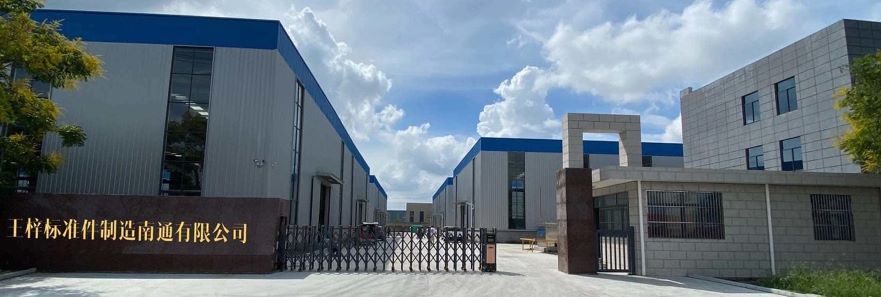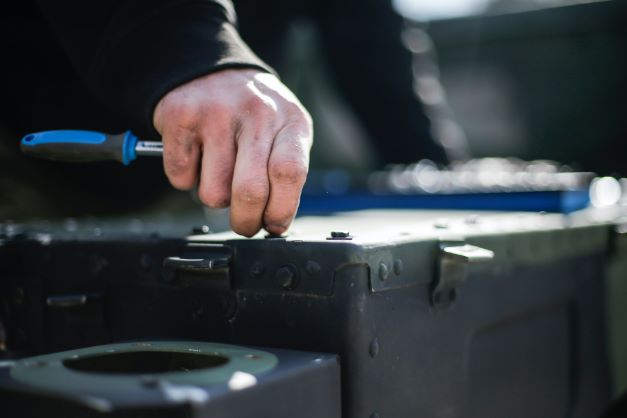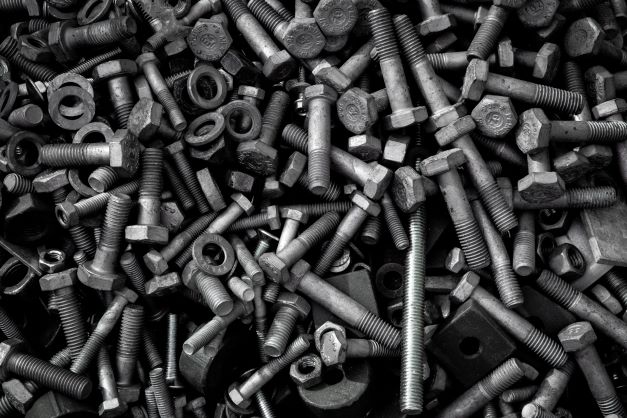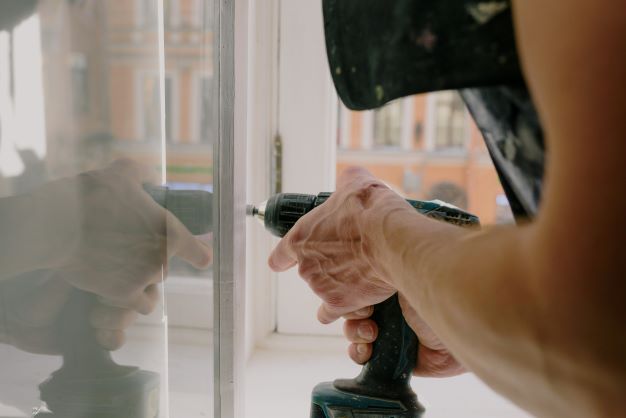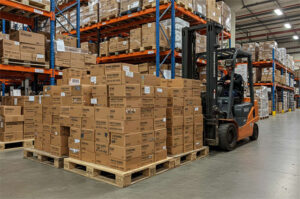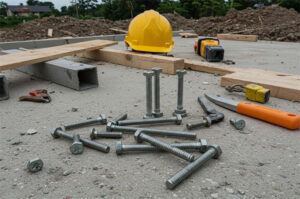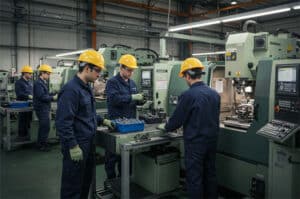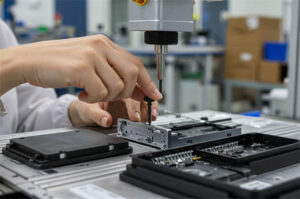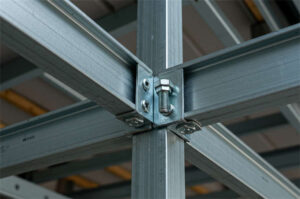What are the types of nuts, bolts, and screws?
Nut, bolts, and screws are fasteners widely used in almost every product available in the world today. They provide an excellent fastening solution for joining and holding materials or surfaces with proposing function considering the factors that can involve its overall effectiveness.
This article will state the different types and classifications of nuts, bolts, and screws, the materials used in their production, and the finishings/coatings.
Nuts
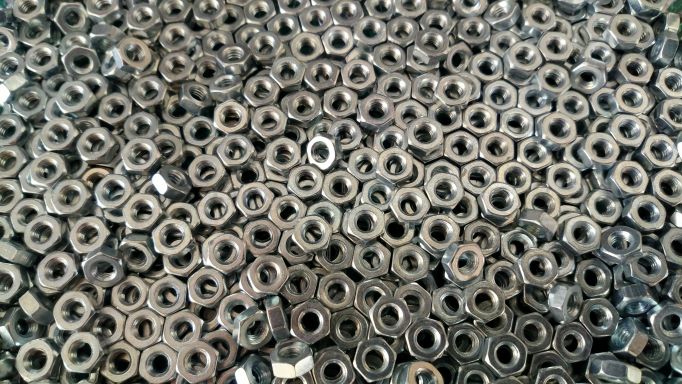
Unlike the other fasteners, nuts must be inserted through bolts for practical fastening. Nuts are mechanical devices for tightening and enhancing the strength in the hold of bolts. They are paired together to perform an excellent joining force on surfaces. They come in variations of required kinds and can fill in the type of thread on the shaft of bolts and rods. Usually, nuts form hexagonal, circular, and square prisms with internal threading. On a particular requirement of the application, nuts can also be customized into a specific form and type.
13 Nut types include:
- Hexagonal Nut
- Square Nut
- Ring Nut
- Cap Nut
- Cylindrical or Capstan Nut
- Dome Nut
- Wingnut or Thumb Nut
- Flange nuts
- Slotted hex nuts
- Locknuts
- Panel nuts
- Coupling nuts
- Surface mount nuts
- Hexagonal Nut
○ Are six-sided or hexagonal-shaped nuts usually used with hex bolts but are not limited to other types of bolt pairing
○ Can be produced in cold or hot forming
○ Sub-types: Fully-threaded hex nuts, partially threaded hex nuts, metric hex nuts, imperial hex nuts
- Square Nut
○ Four-sided nuts that thread into steel bolts
○ They have more significant surface contact compared to standard hex nuts and propose a comprehensive hold on flat areas
○ Can be customized in materials and finishings to have excellent performance
○ Available coatings/finishings: steel, plain, zinc, zinc phosphate, cadmium, hot dip galvanized (HDG), and others
- Ring Nut
○ Responsible for mounting plugs on threaded bolts
○ With a metric internal threaded suitable for steel anchors or rods in chemical fixings
○ Can also be applied in concrete and hollow surroundings
- Cap Nut
○ Commonly known as acorn nut, which has a visual cap feature to protect the thread of bolts underneath it
○ Suitable for applications in building, machinery, and furniture
○ Often made of materials like stainless steel and plated steel
- Cylindrical or Capstan Nut
○ Cylindrical-shaped nut with drilled holes in its circumference
○ A tommy bar is used to turn the nut in applications
- Dome Nut
○ Are another type of acorn nut that is usually used for its protective feature
○ Provides safety to human skin from mishaps of installation
○ Can be used with different threaded fasteners
- Wingnut Nut
○ provides a function in gripping objects together
○ They are twisted at the end of bolts to prevent the connecting objects from loosening
○ Usual material grades include stainless steel, aluminum, brass, silicon, bronze, and steel
- Thumb Nuts
○ Has a similar function to a wing nut, except they can’t be used in structural applications
○ It features a ridged circular head that can be tightened by hand or pliers
○ Commonly found in computers and other areas that don’t need a tooling
- Flange nuts
○ Are considered a particular type of nut because of its wide flange in one end
○ Has a feature of an integrated washer that distributes the pressure on materials
○ Usually used in vehicles
- Slotted hex nuts
○ Features a six-slotted side that allows fastening and locking
○ They are designed to be used with bolts and screws
○ Once installed, slotted hex nuts are placed with a cotter pin or safety wire lacing to prevent loosening and unscrewing
- Locknuts
○ Also known as self-locking nuts because of their locking capabilities
○ They are engineered to prevent loosening in applications due to vibrations or torque
- Panel nuts
○ Are kind of nuts that have a shallow profile because of their characteristics
○ Specifically designed for securing small threaded components
○ Usually used in an application with a washer or spring
○ Commonly produced in materials like brass, nylon, and stainless steel
- Coupling nuts
○ Joins two threaded rods and pipes together hence its name coupling nut or extension nut
○ With a hex-shaped exterior that allows turning when installed by a wrench tool
○ Usually made of materials like carbon steel, stainless steel, brass, and aluminum
Common materials used in the production of nuts:
Low carbon steel
Medium carbon steel
Low carbon martensite steel
Weathering steel
Alloy steel
Medium carbon alloy steel
Options for finishing and coatings on nuts:
Anodizing
Armor coating
Black oxide
Blue phosphate
Chrome plating
Hot-dipped galvanized
Yellow passivated
Zinc coating
Bolts
Bolts are standard mechanical fasteners that provide excellent holding force in applications with joining components like nuts and washers. This fastener is composed of variability in types from its parts such as head, drive, shank, shaft, and thread.
Read more>> How are bolts manufactured?
Parts of Bolts:
Head
Head drive
Washer face
Shank/Body
Thread
Point/Tip
The 27 different forms of bolts:
- Anchor Bolts
- Arbor Bolts
- Blind Bolts
- Carriage Bolts
- Elevator Bolts
- Eye Bolts
- Flange Bolts
- Hex Bolts
- Hull Bolts
- J-Bolts
- Lag Bolts
- Machine Bolts
- Hanger Bolts
- Penta-Head Bolts
- Plow Bolts
- Rock Bolts
- Round Head Bolts
- Serrated Flange Bolts
- Sex Bolts or Chicago Bolts
- Shoulder Bolts
- Socket Head Bolts
- Square Bolts
- Stud Bolts
- T-Head Bolts
- Tap Bolts
- Toggle Bolts
- Track Bolts
- U-Bolts
- Anchor Bolts
○ are usually used in the construction industry for joining components into concrete surfaces or bases of steel poles
○ Two classifications of anchor bolt fasteners are cast-in-place anchor bolts and drilled-in-place anchor bolts.
○ While the common types of anchor bolts are headed anchor bolts and bent anchor bolts
- Arbor Bolts
○ they have reversed threads that are specifically made with the use of power tools such as a miter saw
○ The characteristic of Arbor bolt fasteners is that they usually have black finishing and a washer permanently attached to their head
- Blind Bolts
○ generally involve three parts, a steel pin, a collar, and a sleeve
○ It allows the fastening of materials from one side of the pre-drilled hole to the restricted area, locking them completely
- Carriage Bolts
○ the name was invented for its original purpose of constructing carriages in the early years
○ They are mainly used in wood base materials and wood-to-metal applications
- Elevator Bolts
○ as the name implies were initially used in elevator systems because it doesn’t interfere with their operations
○ Elevator bolt fasteners are partially threaded with a flat round head
- Eye Bolts
○ are used to lodge forces from above or below with is loop ring on the end for the connection point of rigging, hoisting, lifting, anchoring, and pulling applications
- Flange Bolts
○ consists of a flange head that acts like a washer distributing the load on the broader area
○ They are helpful in areas of automotive, piping systems, plumbing, and more
- Hex Bolts
○ also known as machine screws, Hex bolts, or Hexagonal Head bolt fasteners are used in tight spaces like buildings, bridges, highway structures, and more
- J-Bolts
○ are bolts with a bent part or J-shaped bolt fasteners often to secure walls to concrete foundations
- Lag Bolts
○ is one of the most demanding fasteners and is also technically considered a screw because of the lack of need for nuts
○ They are usually used in areas that give heavy loads like lumber or wooden materials
- Machine Bolts
○ generally have a hex or square head for easy wrench use
○ Machine bolt fasteners can come in different sizes for higher effectiveness of fastening materials together
- Hanger Bolts
○ are made of half lag-screw and machine-bolt thread with an end user to tap into surfaces of timber construction
- Penta-Head Bolts
○ are five-headed bolts (pentagon-shaped) that require a unique socket tool for installing and loosening
○ They are used in securing polymer concrete vaults, meter boxes, pole top transformers, and others
- Plow Bolts
○ are usually used in heavy equipment because of their characteristics to tighten and sit flush within their countersunk heads
○ Plow bolt fasteners are similar to carriage bolts that are commonly used in wood applications
- Rock Bolts
○ is a type of anchor bolt that supports a framework for stabilizing slopes
○ They are used in underground mining, tunneling, or any rock structures
- Round Head Bolts
○ button heads or round head bolts are used in wood materials and are similar to carriage bolts
- Serrated Flange Bolts
○ this type of bolt has a circular flange under the head with a teeth grip that holds into surfaces tightly to resist vibrations and loosening
○ They are everyday use in plumbing and electronic product casings
- Sex Bolts or Chicago Bolts
○ are mating bolt fasteners known by many names and have a variety of use
○ The Sex Bolt consists of a female barrel component and a male threaded screw combining a nut and a screw with components that serves as a binding material on gaps of two parts
- Shoulder Bolts
○ features a large unthreaded part under its heads which extends into the embedded surface for the ability to move around
○ It is usually applied in mechanical situations such as engines, linkages, pulleys, and vacuum systems
- Socket Head Bolts
○ also known as socket head cap screws and are machine screw that requires wrench tools for turning
○ These bolts are internally threaded and are suited for applications in confined spaces like machine assembly
- Square Bolts
○ lag bolts or lag screws provide a rustic look to match old structures because of their prominent head feature that allows an easy tooling situation with the use of a wrench
- Stud Bolts
○ are essentially a substitute for bolt and nut assembly with external threads on both ends of the shaft, which is then installed with the use of a hexagon nut
○ This bolt fastener is also known as a double-headed screw used in high-pressure boltings in the petrochemical and pipeline industries
- T-Head Bolts
○ otherwise known as Hammer-head bolts, tank-strap bolts, and T-bolts showing extensive T-shaped features are used in band clamp and fastening lift guide rails that sit flush on surrounding material
- Tap Bolts
○ are fully threaded hex bolts with similar tolerance to cap screws and are used to attach motors to machines or in automotive and industrial applications
- Toggle Bolts
○ has an increased loading capacity compared to a regular bolt fastener
○ They contain spring-loaded wings which expand in the hollow wall once installed
○ Generally used in hanging items inside the household like plants, bookshelves, and ceiling fans
- Track Bolts
○ are used on railway tracks and are commonly made with high-strength steel treated with a finishing of corrosion resistance and are added with vibration material such as a washer
- U-Bolts
○ is a curved metal rod in U-shaped with threaded ends on both sides
○ Used in hanging and securing pipes, tubes, and other structures in need of restraint
Common materials used in the production of bolts:
carbon steel
Stainless steel
Low carbon martensite steel
Weathering steel
Alloy steel
Medium carbon alloy steel
Bronze and brass
Nylon
Options for finishing and coatings on bolts:
Plain finish
Class 3
Anodizing
Armor coating
Black oxide
Blue phosphate
Chrome plating
Hot-dipped galvanized
Yellow passivated
Zinc coating
Electro galvanized
Grey phosphate
Ceramic coated
Screws
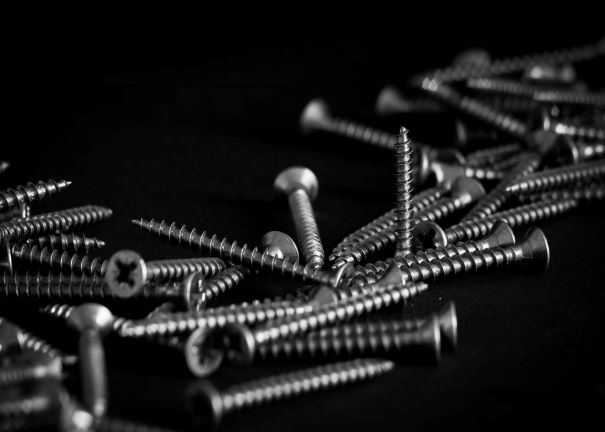
With the standard features of a fastening solution, screws are considered the most popular and commonly used type of fastener. It features a sharp drill end for an easy installation and a male or female threaded body that allows a tight grip on the surrounding materials. Screws can be manufactured in specification and custom details to meet the requirements of surface materials.
They propose different effectiveness than bolts and nuts because of their individuality in the application. Screws are efficient solutions in securing usual industrial needs like construction, household modifications, woodworking, metal sheet applications, etc.
Read about >> How is a screw made?
Parts of Screws:
Head
Head drive
Washer face
Shank/Body
Thread
Point/Tip
28 Types of screws:
- Decking screws
- Double-ended screws
- Drywall screws
- Eyebolt screws
- Framing screws
- Fillister head screws
- Hex cap screws
- Hammer drive screws
- Lag screws
- Machine screws
- Masonry screws
- Oval head screws
- Pan-head screws
- Particle board screws
- Square head bolts
- Set screws
- Shoulder screws
- Sheet metal screws
- Socket-head screws
- Thread cutting screws
- Washer-faced screws
- Weld screws
- Tamper-proof screw
- Custom screws
- Chipboard screws
○ Are a type of self-tapping screw that has a single thread running from base to end
○ Commonly used in woodworking, especially in wood-to-wood applications
- Decking screws
○ A mechanical type of screw explicitly designed for decks
○ With the usual feature of the head, shaft, and tip, deck screws have deep threads that secure their grip on wood
- Double-ended screws
○ Also known as dowel screws, designed as a headless fastener
○ With its double threading features, this screw is used in creating a hidden joint
○ They are designed to be inserted in a pre-drilled pilot hole which provides a strong assembly of the pieces it is holding together
- Drywall screws
○ Have light materials and feature designed to have deeper threads
○ They secure full sheets of drywall, plasterboard, metals, and timber
- Eyebolt screws
○ This type of screw is popular in rigging hardware (anchoring, pulling, pushing, or hoisting applications)
○ Its a screw with an eye-like feature or loop head that can be tied with ropes, wires, and cables
○ Proposes two different types: shouldered eye and non-shouldered eye
- Framing screws
○ Are an alternative to nails
○ performs in better securing of the hold, which reduces torque
○ Have multiple applications and are easily removable
○ Used metal sheet, wood, and composite decking (cabinets and deck building)
- Fillister head screws
○ Sometimes called cheese head screw
○ Similar to pan head machine screw but have a greater side height
○ Popular in manufacturing and automotive applications
- Hex cap screws
○ Six-sided (hexagonal) screws with a washer face on the bearing surface
○ Majorly used in docks, bridges, road structures, and buildings
- Hammer drive screws
○ Are categorically type of a self-tapping screw with a rounded head and no slots
○ They have a similar function to nails that are driven by a hammer or mallet in assembly but require a pre-drilled hole in installation
○ These screws are used for attaching nameplates or wall signs
- Lag screws
○ A type of screw used in heavy work like construction
○ Comes in hex heads and a tubular shank
○ They can bear heavy loads in construction because of the long length of Machine screws
- Machine screws
○ Hold parts of machines in industries of electronic, engineering, and manufacturing equipment
○ They provide a tremendous tensile hold that secures the fastening of parts together
○ Made in materials like brass, steel, carbon, and even nylon
- Masonry screws
○ Used in concrete and brick materials
○ With the need for strength in hold for heavy-duty applications
○ Two types of head: flat head and countersunk
- Oval head screws
○Are shorter screws in length with trim heads about halfway above their surface
○ Provides a feature decorative look in applications
- Pan-head screws
○ Usually applied in securing metals like automotive and machine parts
○ These screws can be a categorically part of self-tapping, self-drilling, and machine screws
- Particle board screws
○ Are full-length threaded screws that are lightweight
○ designed for composite wood such as driftwood, usually used by cabinet makers
- Square head screws
○ Similar to hex cap screws but with a four-sided head forming like a square
○ They are designed with a corresponding type of nuts for successful application
- Self-tapping screws
○ Comes in types of ends like flat, blunt tip, sharp, and piercing tip
○ The type of screw that provides a tapping feature on the surface as it is driven for installation
○ They can be applied to metals, wood, and plastic
- Self-drilling screws
○ Are highly pointed screws that provide an easy installation on materials without the need for a pre-drilled hole
○ They are famous for efficiency and use in metals and wood
- Set screws
○ Are fully threaded screws that are used in securing an object against another object
○ Their headless feature allows them to be entirely buried inside a hole
- Shoulder screws
○ Fits in one part providing a free rotating joint of connection on the other side
○ Acts as a shaft for rotating items such as shoulder bearings
- Sheet metal screws
○ Includes a sharp pointed end and threaded shank for binding and joining metals together
○ They provide excellent security and tighten the hold
- Socket-head screws
○ Is a type of machine screw that has a cylindrical barrel-shaped head in a hexagonal socket
○ They are highly resistant to corrosion and provide an attractive finish
- Thread cutting screws
○ Have sharp edges and are slightly longer than standard screws
○ Often used in metal and wood and ideal for tough surfaces
- Washer-faced screws
○ Acts as springs that provide a distance between the nut and head of the screw
○ The washer feature of this screw is located below the head, which allows a smooth bearing and tight installation
○ Available in different types and sizes
- Wood screws
○ As the name suggests, they are vast use in wood pieces with a variety of head types
○ Commonly made from brass, steel, and bronze materials
- Weld screws
○ This screw needs to be welded to a metal surface
○ It protrudes from the head that, allows the welding without any hole
○ Used in automotive, industrial, marine, construction, and aerospace
- Tamper-proof screw
○ Are made impossibly to remove when installed as means to prevent the destruction
○ They are a type of safety screws determined by their drive and difficulty in tampering and removal
- Custom screws
○ Are any types of screws made from drawings or special requirements such as the materials, coatings, length in diameter, shape, size, etc.
Common materials used in the production of screws:
carbon steel
Stainless steel
Low carbon martensite steel
Weathering steel
Alloy steel
Medium carbon alloy steel
Bronze and brass
Nylon
Different grades of steel
Options for finishing and coatings on screws:
Plain finish
Class 3
Anodizing
Armor coating
Black oxide
Blue phosphate
Chrome plating
Hot dipped galvanized
Yellow passivated
Zinc coating
Electro galvanized
Grey phosphate
Ceramic coated
Differentiating the three kinds of fasteners and their types should give you an idea of which component is best suitable for your project applications. With the individual function of nuts, bolts, and screws, they are subjected to their qualities and performances for a successful application.
You can reach us to know more about the products and their technicality, and we will answer your inquiry immediately.
A leading fastener supplier Prince Fastener Manufacturing Co., Ltd.
